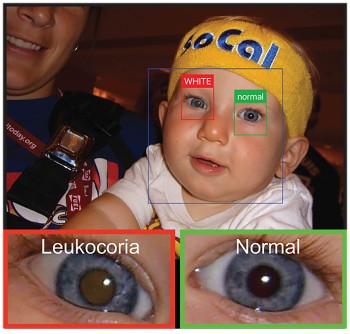- Home
- Editorial
- News
- Practice Guidelines
- Anesthesiology Guidelines
- Cancer Guidelines
- Cardiac Sciences Guidelines
- Critical Care Guidelines
- Dentistry Guidelines
- Dermatology Guidelines
- Diabetes and Endo Guidelines
- Diagnostics Guidelines
- ENT Guidelines
- Featured Practice Guidelines
- Gastroenterology Guidelines
- Geriatrics Guidelines
- Medicine Guidelines
- Nephrology Guidelines
- Neurosciences Guidelines
- Obs and Gynae Guidelines
- Ophthalmology Guidelines
- Orthopaedics Guidelines
- Paediatrics Guidelines
- Psychiatry Guidelines
- Pulmonology Guidelines
- Radiology Guidelines
- Surgery Guidelines
- Urology Guidelines
A Smartphone App helps parents detect early signs of white eye in children, Study Finds

Lately, there is a spate of smartphone Apps for diagnosing and managing various diseases. The latest is a smartphone application that has been developed to help parents detect early signs of eye disease by searching their children’s photographs for traces of leukocoria, also known as “white eye.”
The prototype app (CRADLE: ComputeR Assisted Detector LEukocoia) was engineered to autonomously search for the disorder in casual photos of children and make them available under a free download called “White Eye Detector.” The free app has been made available for Android and iPhone devices. Early detection means that children have better vision, better development, and in the case of retinoblastoma, increased chances of survival. Leukocoria is a medical sign for a number of common and rare conditions, among them retinoblastoma, pediatric cataract, Coats' disease, refractive error, amblyopia and corneal scarring.
According to the study's first author, Baylor senior University Scholar Micheal Munson, researchers determined the sensitivity, specificity and accuracy of the prototype by analyzing more than 50,000 photographs of children taken prior to their diagnosis. For children with diagnosed eye disorders, CRADLE was able to detect leukocoria for 80 percent of the children. The app detected leukocoria in photos that were taken on average of 1.3 years prior to their official diagnosis.
The effectiveness of traditional screenings during a general physical exam is limited, with signs of retinoblastoma via the detection of leukocoria in only 8 percent of cases. CRADLE's sensitivity for children age 2 and younger surpassed 80 percent. That 80 percent threshold is regarded by ophthalmologists as the ''gold standard" of sensitivity for similar devices, Munson said.
Researchers found the CRADLE app to be more effective simply by the breadth and frequency of its sample sizes: everyday family photos, according to the study. Given the number of photos taken by family and friends and the variety of environments, there is a variety of opportunities for light to reflect off the ocular lesions regardless of its location in the eye.
Leukocoria, or “white pupil,” is one of the primary signs of retinoblastoma. Leukocoria is often first noticed by family members or on flash photography, and such images can be helpful to the ophthalmologist. However, red-eye removal software in modern cameras may confound the detection of leukocoria. Also, if the subject in the photo is looking approximately 15° off-axis nasally, the optic disc shadow can fill the pupil, giving a white reflex. However, a number of other conditions may also present with leukocoria, and it is critical to differentiate retinoblastoma from this so-called pseudoretinoblastomas for proper management.1 Shields and coworkers have reported 27 different pseudoretinoblastoma conditions.2 Some of the most common include
- Coats disease
- Persistent fetal vasculature (PFV)
- Ocular toxocariasis
- Familial exudative vitreoretinopathy (FEVR)
- Retinopathy of prematurity (ROP)
- Astrocytic hamartoma
- Vitreous hemorrhage
- Coloboma
- Endogenous endophthalmitis
- Rhegmatogenous retinal detachment
The study, has been published in the journal Science Advances, was done researchers from Baylor University, Massachusetts Eye and Ear Infirmary, Harvard Medical School and Dana-Farber Cancer Institute. This study is the first test of the sensitivity and accuracy of the app at detecting "white eye" in casual photographs.

Disclaimer: This site is primarily intended for healthcare professionals. Any content/information on this website does not replace the advice of medical and/or health professionals and should not be construed as medical/diagnostic advice/endorsement or prescription. Use of this site is subject to our terms of use, privacy policy, advertisement policy. © 2020 Minerva Medical Treatment Pvt Ltd